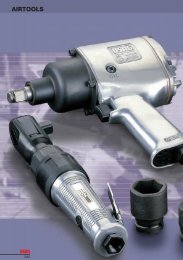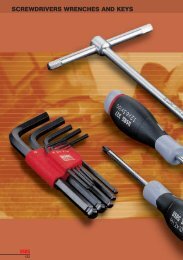Industrial seal self study guide - SKF.com
Industrial seal self study guide - SKF.com
Industrial seal self study guide - SKF.com
You also want an ePaper? Increase the reach of your titles
YUMPU automatically turns print PDFs into web optimized ePapers that Google loves.
Chapter 5—Seal Selection<br />
The first consideration in selecting a <strong>seal</strong> is to know:<br />
• Is it a <strong>seal</strong> for a new application, or<br />
• Is it a replacement <strong>seal</strong> for an existing application?<br />
Selecting <strong>seal</strong>s for new applications is covered in Chapter 4: Seal<br />
Applications. It would seem that selecting a <strong>seal</strong> for an existing<br />
application would be an easier chore. Even so, there are<br />
considerations such as:<br />
• Is an exact replacement <strong>seal</strong> desired, or<br />
• Should an alternative <strong>seal</strong> be selected which would be a “better”<br />
choice for that particular application?<br />
How to Select a Replacement Seal<br />
If the old <strong>seal</strong> was manufactured by <strong>SKF</strong>, you should have no trouble<br />
finding an appropriate identification number and selecting the proper<br />
replacement. <strong>SKF</strong> <strong>seal</strong>s are identified by:<br />
• <strong>SKF</strong> stock number<br />
• <strong>SKF</strong> industrial part number<br />
• <strong>SKF</strong> drawing number<br />
• OEM part number<br />
This number will tell you exactly which replacement <strong>seal</strong> is right for<br />
the job. If the part number on the old <strong>seal</strong> is legible, refer to the <strong>SKF</strong><br />
Master Interchange for a replacement.<br />
If you can’t find an identification number, match the old <strong>seal</strong>’s size<br />
with listings in the <strong>SKF</strong> Handbook of Seals. If there is no <strong>seal</strong> listed<br />
with the exact same width, select a narrower one.<br />
O.D.<br />
Shaft<br />
Diameter<br />
Seal size is determined by <strong>seal</strong><br />
bore, <strong>seal</strong> width, <strong>seal</strong> .D. and<br />
shaft diameter (fig. 5a).<br />
W<br />
Seal Size<br />
Seal size (fig. 5a) is determined by:<br />
• Seal bore the diameter of the hole in the housing into<br />
which the <strong>seal</strong> is fitted.<br />
• Seal Outer Diameter (O.D.)—the press-fit diameter. It’s usually in<br />
the range .004” to .008” (.10mm to .20mm) larger than the bore<br />
for metal O.D.’s. It’s usually .006” to .022” (.15mm to .55mm) for<br />
rubber O.D.’s.<br />
• Seal Width (W)—the total width of the <strong>seal</strong> including both<br />
the inner and outer shell.<br />
• Shaft Diameter (S.D.)—the outside diameter of the shaft<br />
at the location where the <strong>seal</strong> is mounted.<br />
46







